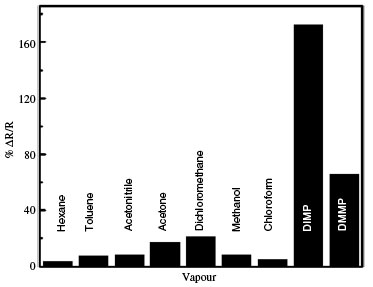| Posted: Jan 29, 2007 | |
Real-time chemical warfare sensors built with nanotechnology |
|
| (Nanowerk Spotlight) As their name suggests, nerve agents attack the nervous system of the human body. All such agents function the same way: by interrupting the breakdown of the neurotransmitters that signal muscles to contract, preventing them from relaxing. Nerve agents, depending on their purity, are clear and colorless or slightly colored liquids and may have no odor or a faint, sweetish smell. They evaporate at various rates and are denser than air, so they accumulate in low areas. Nerve agents include tabun(GA), sarin(GB), soman(GD), and VX. The military has a number of devices to detect nerve agent vapor and liquid. Current methods to detect nerve agents include surface acoustic wave (SAW) sensors, conducting polymer arrays, vector machines, and the most simple, color change paper sensors. Most of these systems have have certain limitations including low sensitivity and slow response times. By using readily synthesized network films of single-walled carbon nanotube bundles researchers have built a sensor capable of detecting G-series nerve agents such as Soman and Sarin (Sarin was used in the Tokyo subway terrorist attack in 1995). This research opens new opportunities in the design of real-time chemical warfare agent (CWA) sensors with independent response signatures. | |
| Carbon nanotubes were first used for organic vapor sensing as chemiresistors, where resistance changes in nanotubes were monitored continuously with time upon exposure to vapors ("Extreme Oxygen Sensitivity of Electronic Properties of Carbon Nanotubes"). Subsequently, these studies were extended to include a larger diversity of organic vapors, including nerve agent simulants ("Single-Wall Carbon Nanotube Interaction with Gases: Sample Contaminants and Environmental Monitoring"). | |
| Researchers at the University of Texas in Sanjeev Manohar's Group previously have described an extremely simple method to obtain thin, optically transparent, strongly adherent films of single-walled carbon nanotube (SWNT) bundles on flexible plastic substrates such as PET. These SWNT/PET films can also be used for organic vapor sensing (hexane, toluene, acetone, chloroform, acetonitrile, methanol, etc.). Most recently, Manohar and his team have shown that unusually large, reproducible resistance changes can be observed when SWNT/PET sensors are exposed to CWA simulants for the G-series nerve agents such as DIMP (diisopropyl methylphosphonate) and DMMP (dimethyl methylphosphonate). | |
 |
|
| Sensor response of SWNT/PET device to common organic solvent vapors and DIMP and DMMP under saturated vapor conditions. (Reprinted with permission from IOP Publishing) | |
| The experiments yielded a robust sensor response to CWA simulants even in the presence of large amounts (30 000 ppm) of interferent vapors commonly found in battle-space and urban air environments. The researchers found that the use of polyisobutylene as a barrier coating polymer that can screen out high concentrations of interferent vapor signatures. | |
| These SWNT/PET films are extremely easy to fabricate using the line patterning method. This is a simple and rapid room temperature method (involving no lithography or printing). Sensor patterns are drawn on a computer and then printed on overhead transparency (PET) sheets. These PET patterns are coated with films of electronically conductive SWNT bundles (1–2 µm thick) by dip-coating in aqueous surfactant-supported dispersions and mounted in glass chambers equipped for vapor sensing. | |
| While the method has many advantages, the researchers point out that device resolution is limited to what can be achieved using a conventional commercial laser printer (20 µm). This study, therefore, is an attempt to demonstrate the generality of the phenomenon of simulant sensing using these flexible SWNT-based sensors, and not an attempt to optimize device fabrication to drive down detection limits (ppb levels). | |
| Nevertheless, while significant challenges remain in optimizing sensor performance with regard to tunability, stability, detection limit, elimination of false positives, etc, these findings open new opportunities in the design of real-time CWA sensors with independent response signatures. | |
| The researchers published their findings in Nanotechnology "Flexible carbon nanotube sensors for nerve agent simulants". | |
 By
Michael
Berger
– Michael is author of three books by the Royal Society of Chemistry:
Nano-Society: Pushing the Boundaries of Technology,
Nanotechnology: The Future is Tiny, and
Nanoengineering: The Skills and Tools Making Technology Invisible
Copyright ©
Nanowerk LLC
By
Michael
Berger
– Michael is author of three books by the Royal Society of Chemistry:
Nano-Society: Pushing the Boundaries of Technology,
Nanotechnology: The Future is Tiny, and
Nanoengineering: The Skills and Tools Making Technology Invisible
Copyright ©
Nanowerk LLC
|
Become a Spotlight guest author! Join our large and growing group of guest contributors. Have you just published a scientific paper or have other exciting developments to share with the nanotechnology community? Here is how to publish on nanowerk.com.
